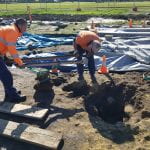Yes, yes, it’s been a while I know. We’ve been BUSY. Plus, there’s been rain, other things to do and – most importantly – I really haven’t had the energy to write anything.
Work is just about complete on getting off the last of what we are calling the ‘interface’ deposits of the foundry. These are the silts and clays that accumulated directly over the convict period foundry deposits, likely during the 1880s salvage of the structure. As you can imagine, tearing down a building is messy business, as the fittings are removed, roof taken off and walls ripped down. What often happens – particularly in a space like the foundry which likely had an earthen floor – is that the intact convict period deposits get trampled, mixed and then covered in brick, mortar and sandstone rubble. This creates a disturbed ‘interface’ zone. It contains convict period deposits and artefacts, but these have been moved around, kicked about and mixed with post-convict deposits.
Despite this, the interface still contains important information that we need to recover. We’ve been taking soil samples from every 1m x 1m square and sieving deposits through a 4-10mm screen (to recover artefacts). All this will be analysed during the post-fieldwork phase.
We’re finding that the site has been quite heavily disturbed by post-convict activity. There’s quite a few postholes and pits dug across the site, likely from when the area was grassed over and the backyard of a nearby museum. Some may be from early 20th Century attempts at ‘archaeology’. Rabbits have also taken quite a toll on the site, as evidence of their tunnels and burrows is everywhere. These have been dug through the soft deposits, but also through the base of the forge (the feature with the orange safety cones sticking out of it in the photo above).
After Easter we’ll be once again cleaning the site to prepare it for another round of photogrammetry, after which time we’ll be getting stuck in to the foundry deposits proper. We’re not really sure how thick and intact that are – nor what lies below them. Here’s hoping we find evidence of those earlier 1835-54 workshops…



